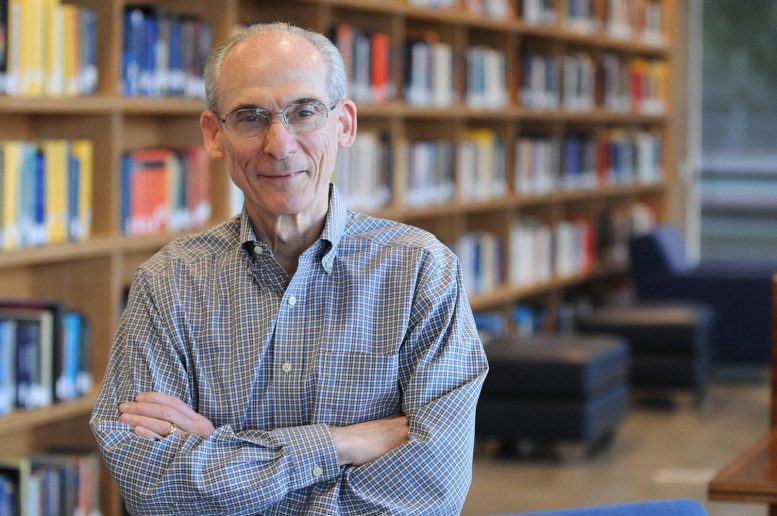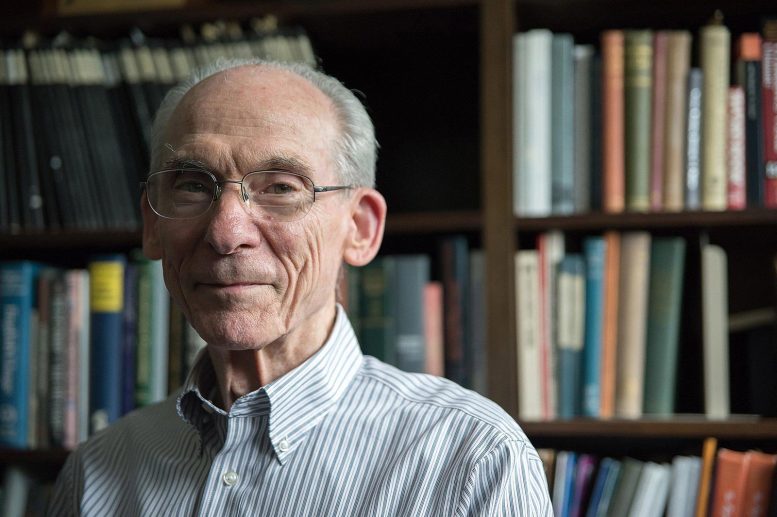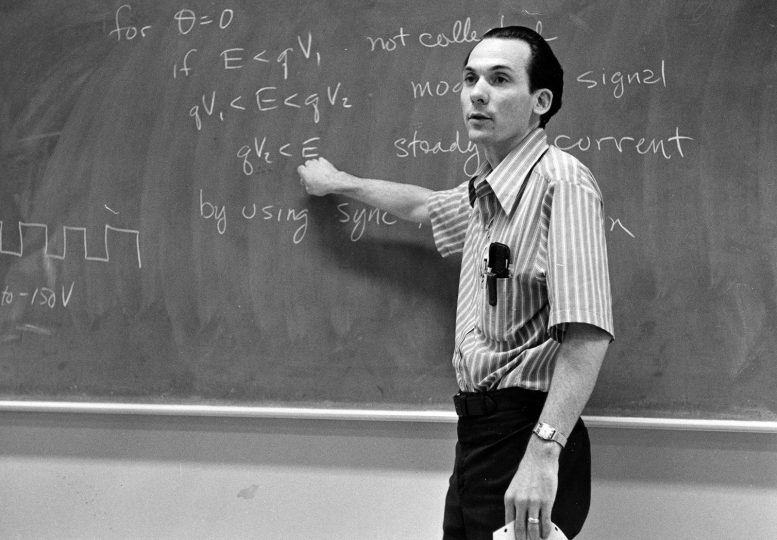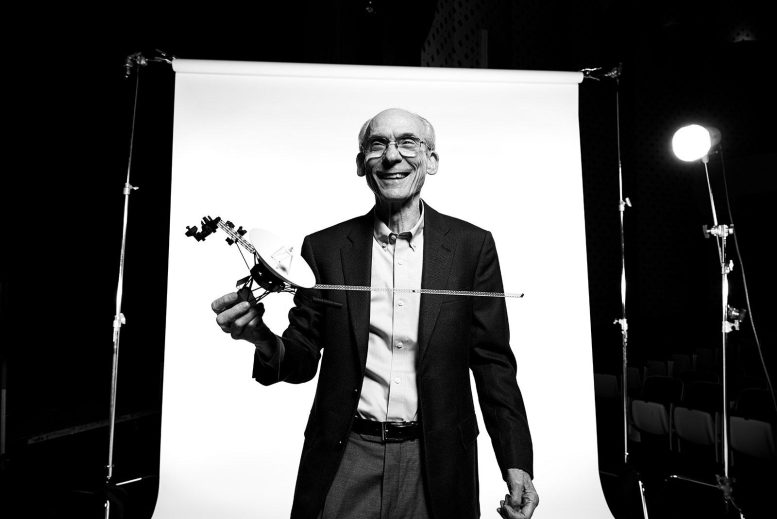
Dr. Edward (Ed) Stone. Credit: Caltech
Edward C. Stone, renowned for his leadership of the Voyager spacecraft missions and his role in advancing space and planetary astronomy at Caltech and JPL, has died at 88. His career included directing JPL and contributing to the development of the Keck Observatory and the Thirty Meter Telescope.
Remembering Edward C. Stone
Edward C. Stone, Caltech’s David Morrisroe Professor of Physics, Emeritus, passed away on June 9. He was 88 years old.
A giant in the fields of space physics and planetary astronomy, Stone spent six decades at Caltech, leading numerous space missions, overseeing the construction of the W. M. Keck Observatory, establishing the Institute’s Space Radiation Lab, serving in distinguished leadership roles, and paving the way for the next generation of giant telescopes.

Dr. Stone in his office. Credit: Caltech
Legacy in Space Exploration
Stone was perhaps best known for his role as project scientist for NASA’s twin Voyager spacecraft, a project of discovery that he spearheaded for 50 years. Always bringing a sense of wonder, an encyclopedic knowledge, and a spirit of exploration to his work, Stone led the Voyager project through its tour of the outer planets—a remarkable journey that included the first encounter with volcanism outside Earth in 1979—and through its later years when both spacecraft made history by crossing into interstellar space in 2012 and 2018.
“Ed Stone was a man in constant motion, chasing the unknown, just like the space missions he guided,” says Caltech President Thomas F. Rosenbaum, the Sonja and William Davidow Presidential Chair and professor of physics. “A great scientist, a formidable leader, and a gifted expositor of discovery, Ed will be missed sorely by all who he inspired at Caltech and in the astronomy community at large.”

Dr. Stone in a classroom. Credit: Caltech Archives
Leadership at JPL and Beyond
In 1991, Stone was named director of the Jet Propulsion Laboratory (JPL), which is managed by Caltech for NASA. He remained in that role until May 2001, during which time he oversaw 21 different missions and instruments, including the Mars Pathfinder Soujourner rover, the first wheeled vehicle to operate on another planet.
“Ed will be remembered as an energetic leader and scientist who expanded our knowledge about the universe—from the Sun to the planets to distant stars—and sparked our collective imaginations about the mysteries and wonders of deep space,” says Laurie Leshin (PhD ’95), JPL director and Caltech vice president. “Ed’s discoveries have fueled exploration of previously unseen corners of our solar system and will inspire future generations to reach new frontiers. He will be greatly missed and always remembered by the NASA, JPL, and Caltech communities and beyond.”

Dr. Stone with the Voyager scale model. Credit: Mario de Lopez for Caltech
Pioneering Ground-Based Astronomy
Stone’s work to open the farthest reaches of space to exploration went beyond space missions. From 1983 to 1988, he served as chair of the Division of Physics, Mathematics and Astronomy at Caltech. While in that role, he oversaw the establishment of the Laser-Interferometer Gravitational-wave Observatory (LIGO), which, decades later, made the first direct detection of ripples in space and time called gravitational waves. He also served on the board of the California Association for Research in Astronomy (CARA) for nearly 25 years. As part of his leadership roles there in the mid 1980s through the 1990s, he oversaw the construction of the W. M. Keck Observatory, one of the most productive ground-based astronomical observatories in the world. He was also on the board of the W. M. Keck Foundation.
Inspired by the overwhelming success of Keck, Stone became involved in the Thirty Meter Telescope (TMT), a giant telescope proposed to reside, like Keck, atop Maunakea in Hawai’i. Stone joined the TMT Corporation in 2004, and became the founding executive director of the TMT International Observatory LLC in 2014, a role he remained in until 2022.
“It is hard for me to think of any scientist today with a scientific legacy as broad and multifaceted as Ed’s,” says Fiona A. Harrison, the Kent and Joyce Kresa Leadership Chair for the Division of Physics, Mathematics and Astronomy, and Harold A. Rosen Professor of Physics. “He made major contributions to cosmic ray and space physics, planetary exploration, solar physics and ground-based astronomy. His knowledge was encyclopedic and his enthusiasm for exploring the cosmos unbounded. Personally, he influenced me profoundly as a mentor, colleague, and co-leader of the Space Radiation Lab and I already miss his advice and friendship tremendously.”
Early Life and Education
Born in Knoxville, Iowa, on January 23, 1936, Stone grew up on the banks of the Mississippi River in nearby Burlington, Iowa, and received his undergraduate education at Burlington Junior College (now Southeastern Community College). “Our father was a construction superintendent who enjoyed learning new things and explaining how they worked,” he wrote in an autobiography upon being awarded the 2019 Shaw Prize in Astronomy, a prestigious honor bestowed for his leadership in the Voyager project.
“As a homemaker, our mother created a warm, welcoming, and nurturing space for our family,” Stone wrote. “Both parents had a strong work ethic… They encouraged my pursuit of scientific and technical activities such as building radios and other electronics. My physics teacher further advanced my scientific and laboratory experience and it was due to his urging that I enrolled at the University of Chicago.”
In 1957, one year after Stone entered graduate school at the University of Chicago, the then Soviet Union launched Sputnik 1, the world’s first human-made space satellite. The space race was on, and advances in propulsion technology paved the way for scientific exploration above and beyond Earth. Stone was inspired by his doctoral advisor, Professor John Simpson, whose interests were in cosmic rays—fragments of high-speed atoms that originate from the Sun and beyond before raining down on Earth.
Stone performed his first cosmic ray experiments in 1961 while working on Discover 36, a since-declassified spy satellite that took photographs of Earth. He built an instrument that rode aboard the satellite and measured the intensity of cosmic rays. The work, which became the subject of his PhD thesis, helped improve our understanding of the Van Allen belts, energetic particles trapped in Earth’s magnetic field.
Contributions to Space Physics
Stone joined Caltech in 1964 and began working with Rochus (Robbie) Vogt, the R. Stanton Avery Distinguished Service Professor and professor of physics, emeritus, whom he had first met as a graduate student at the University of Chicago. Vogt had let Stone take over a workbench in his Chicago lab.
After Vogt moved to Caltech to become an assistant professor, he asked Stone to join him as a postdoctoral fellow. (Stone went on to become an assistant professor in 1967, a full professor in 1976, and the David Morrisroe Professor of Physics in 1994.) The two helped put Caltech on the map as a leader in the budding field of space physics. They worked on a number of NASA satellite missions, including the Orbiting Geophysical Observatory and the Interplanetary Monitoring Program, which revealed details of how the elements are made from galactic cosmic rays and how particles from the Sun behave. Their experiments also showed that cosmic rays are made up of atomic nuclei and not gamma rays, as had been previously theorized. The two also established the Space Radiation Lab at Caltech, which continues to play a key role in many astrophysics space missions.
In 1972, managers at JPL offered Stone the position of project scientist of the Voyager mission.
“I have known Ed Stone for 57 years and I worked closely with him on almost a daily basis for the last 51 years. I feel he is the smartest man I ever met,” says Alan Cummings, senior research scientist for the Space Radiation Lab. Cummings began working alongside Stone as a graduate student in the 1960s. “He was a tremendous scientist, as evidenced by him winning the Shaw Prize, among other awards and honors. He was a great multi-tasker, for example, being JPL director for 10 years while at the same time working with me on a daily—well, mostly nightly—basis on our Voyager data. He was my boss, my colleague, and my friend, and I will miss him tremendously.”
A Grand Tour
The Voyager mission was designed to take advantage of a rare alignment of Jupiter, Saturn, Uranus, and Neptune. JPL scientists had realized that, in 1977, the planets would be arranged in such a way that their gravity would be able to boost the spacecraft from one planet to the next. From there, Voyager could make its way beyond Pluto and into interstellar space. The only catch was that this planetary alignment would not happen again for another 176 years. As the project scientist for the mission, Stone helped bring Voyager to the launchpad in just five years: Voyager 1 and Voyager 2 launched in 1977, only two weeks apart. The twin spacecraft took slightly different paths out of the solar system, with Voyager 1 reaching interstellar space in 2012, and Voyager 2 in 2018.
As Voyager project scientist, Stone led 11 instrument teams. (Later, after the mission passed Neptune, only five teams remained that were focused on the journey to interstellar space.)
Some of the mission’s many highlights include the first high-resolution images of Jupiter, Saturn, Uranus, and Neptune; the first images of the rings of Jupiter, Uranus, and Neptune; and the discovery of gaps and other complex structures in Saturn’s rings.
One discovery that Stone remembered fondly took place in 1979, when Voyager 1 encountered unusual spectral signatures and images coming from Jupiter’s moon Io. At first, nobody knew what they were looking at. A Voyager engineer, Linda Morabito, convinced the team they were not looking at just another satellite that happened to be obscuring the view. A couple of days later, Stone recalled his colleague Rudolf Hanel—who was a co-investigator on the Voyager Infrared Experiment—announcing they were looking at lava lakes from the first active volcanoes on a planet outside Earth.
“And that really opened our eyes that we were in for a mission that was really going to stretch us in terms of our understanding of planets, and understanding of Earth,” said Stone in a Caltech video commemorating the 40th anniversary of Voyager. “Time after time, we just found that nature was much more inventive than our models.”
Master of Space Missions
In addition to managing many missions while director of JPL, Stone also helped restructure several projects to keep them afloat in the midst of funding cuts. In the 1990s, after the Cold War, NASA and defense budgets were significantly cut. During this time, Stone oversaw the redesign of the cooling system on NASA’s infrared observatory, the Spitzer Space Telescope, making it more cost effective. As a result, Spitzer operated from 2003 to 2020, and made countless discoveries, such as revealing that the TRAPPIST-1 system contains seven Earth-size planets.
Beyond his administrative duties at JPL, Stone served as either a principal investigator or science instrument lead on nine NASA missions and as a co-investigator (a significant science instrument team member) on five others. One of these missions, the Parker Solar Probe, which launched in 2018, continues to whip around the Sun to study the source of its solar wind—the same wind that carves a bubble, called the heliosphere, around the Sun, from which Voyager 1 and 2 escaped. “In 2012, Voyager 1 finally left the bubble first predicted by Parker, entering interstellar space,” Stone said in a Caltech feature story about the mission, which is named after Caltech alumnus Eugene Parker (PhD ’51).
Suzanne Dodd, who has served as Voyager project manager since 2010, recalls Stone’s calm and collected management approach, in particular during a time when data from Voyager 1 indicated that the spacecraft had indeed crossed into interstellar space.
“Nobody could wait to get to interstellar space, but we wanted to get it right,” Dodd recalled. “We knew there would be people who disagreed. So Ed wanted to understand the full story and the assumptions people were making. He did a good job listening to everybody and letting them participate in the dialogue without anyone monopolizing.”
Stone has received numerous awards, including the National Medal of Science (1991), the Magellanic Premium (1992), the Carl Sagan Memorial Award (1999), the Philip J. Klass Lifetime Achievement Award (2007), and the Howard Hughes Memorial Award (2014). In 2013, on the show “The Colbert Report,” late-night TV host Stephen Colbert presented Stone with the NASA Distinguished Public Service Medal, the agency’s highest honor for a nongovernment individual. Stone was a member of the National Academy of Sciences.
Stone was predeceased by his wife, Alice, and is survived by his daughters Susan and Janet, son-in-law Tom, grandsons Michael and Ryan, and granddaughter-in-law Lauren. A memorial service will be held at a later date. In the meantime, Stone’s family suggests those wishing to celebrate his life might “explore an unfamiliar realm of science, enjoy an opera, hike with family and friends, share a stovetop pan of fresh popcorn, or adventure along a new route home.” In lieu of flowers, the family suggests donations to Caltech’s Summer Undergraduate Research Fellowships (SURF) program, the Planetary Society, or the Los Angeles Opera.
>>> Read full article>>>
Copyright for syndicated content belongs to the linked Source : SciTechDaily – https://scitechdaily.com/edward-c-stone-1936-2024-visionary-of-the-voyager-era/




























